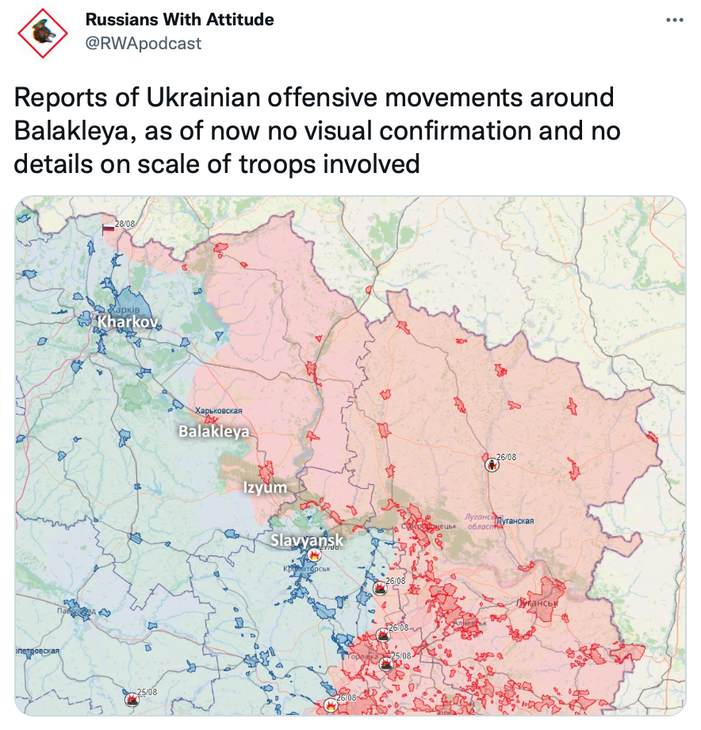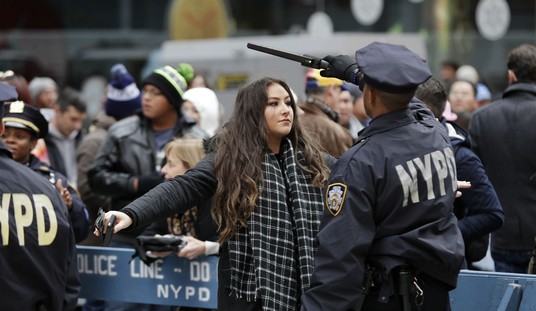Something remarkable appears to be developing in the Ukraine War these last few days, as Kyiv’s long-promised counterattack towards Kherson in the south now looks more like a general counteroffensive all along the front.
But can Ukraine’s forces, stretched and pounded, “keep the skeer” on the Russian Army?
Before we get to that, let’s take a look at the latest reports from Balakleya in the north, Donbas in the center, and towards Kherson in the south.
Kherson Oblast (region) and its capital city were some of Russia’s easiest gains early in the war, and where Moscow has made the most preparation to formally annex. Those include “rubleization” of the local economy, issuance of Russian passports, installing Moscow-friendly civil servants, etc. Preparations for an annexation referendum (of dubious legality and integrity) are well underway.
Ukraine President Volodymyr Zelenskyy has been promising an August offensive to recapture Kherson since June, and now in September tangible results can finally be seen. The campaign started (and continues) with precision strikes on Russian headquarters, ammunition dumps, and bridges across the Dnipro River. The plan is to severely reduce Moscow’s ability to supply its forces on the north (right) bank of the Dnipro, allowing Kyiv to kill, capture, or drive them out without too much of a fight.
Or as Colin Powell famously said in 1991 about Saddam Hussein’s army in Kuwait and southern Iraq, “First, we’re going to cut it off, and then we’re going to kill it.”
If progress is slow, unlike the Gulf War’s 96-hour land action, that’s out of necessity. As the Dupuy Institute’s Christopher Lawrence wrote today:
Ukraine does look to be making progress, bit by bit. Far from a blitzkrieg, but it does look like they have made real progress in two areas to the NE of Kherson and also at Kharkov. Furthermore, this appears to be coordinated with their special operations and insurgency efforts behind the lines, with a Russian official in Zaporizhzhia province killed and another Russian mayor of Berdyansk was car bombed and killed. Furthermore, the Ukrainians appear to have interrupted supplies and mostly taken down the bridges going north of the Dnipro. None of this looks good for Russia.
Another reason for Ukraine to advance slowly: They must husband their resources and manpower, and not repeat the mistakes Russia made in the opening days and weeks of the war.
But none of the action in Kherson, or even Ukraine’s apparent (for now?) successes, come as much of a surprise. Moscow had devoted no more strength than necessary to occupy the region, and has been in a purely defensive posture there for months.
What is a surprise, seemingly almost impossible, is that Ukraine is simultaneously making moves against Russian forces up north near Kharkiv and even in the heavily-occupied Donbas region.
Recommended: Antifa Thug Shoots at Old Man, Kills Antifa Thug
The “Russians with Attitude” podcasters on Tuesday posted a lengthy thread on reported Ukrainian moves towards Balakleya, just southeast of Kharkiv:
“Heavy fighting reported on the outskirts of Balakleya,” RwA continued. “AFU seems to be applying a lot of force here, there are no details but from what I know about the size of the RU garrison there, they may be forced to retreat.”
Later on Tuesday, ISW confirmed those reports and concluded that the attacks “likely drove Russian forces back to the left bank (north side) of the Severskyi Donets and Serednya Balakliika rivers on September 6.”
Retired U.S. Army General Mark Hertling concluded that Ukraine had “regained key terrain that will affect Russian supply lines, w/ the added benefit of depleting RU units & overall RU morale.”
I’d say it’s too soon to draw such broad conclusions about one attack in a comparatively quiet area of the front, but we’ll see.
Ever since Russia was forced to withdraw from around Kyiv and Kharkiv, most of the heavy fighting has been in the Donbas region. The area is heavily industrialized and ethnically is heavily Russian. It’s also home to Ukraine’s two breakaway “people’s republics” that have remained a sore spot (to put it entirely too lightly) between Kyiv and Moscow since 2014.
Wherever Russian forces (or Russian proxies) have pushed in Donbas, Ukraine has retreated. The fighting has been intense and costly for both sides, and Kyiv’s inability to resist advances there has been my big test case for the outcome of the war.
On Sunday, it was confirmed that the Ukraine Army had recaptured the town of Ozerne and established a bridgehead there on the Russian-held side of the Siverskyi-Donets River. On Tuesday, Ukraine was also advancing into nearby Staryi Karavan. Both towns control bridges across the river.
There doesn’t seem to have been much fighting in either town and that raises questions.
- Did Russia make a tactical withdrawal, to trap and destroy UA forces?
- Are Russia’s forces stretched too thin now to defend everywhere? (If so, that doesn’t mean the answer to the first question is necessarily “no.”)
- Are Russian forces simply too exhausted to fight?
The answer to all three is: We don’t yet know. We can’t even say for sure whether Kyiv has truly gone on the counteroffensive, or if their advances in Kharkiv and Donbas were mere targets of opportunity.
The real question might be whether Kyiv can maintain offensive operations long enough to make a real difference before winter weather comes in and brings things mostly to a standstill.
If anything truly big is going to happen for either side, it will probably have to happen within the next six weeks or so.
Stay tuned.











Join the conversation as a VIP Member